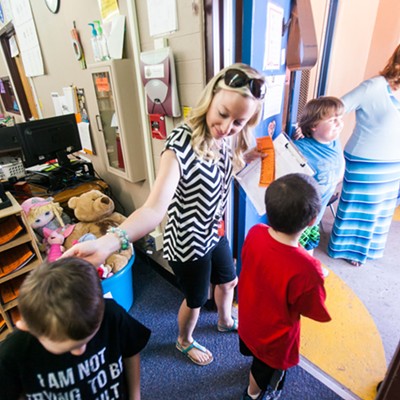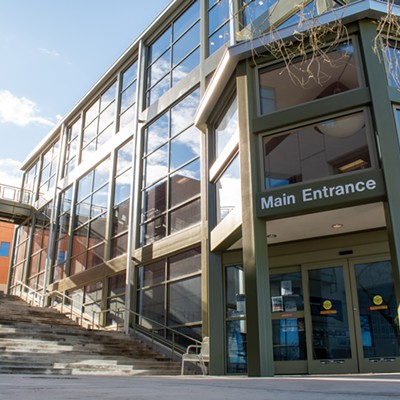Brubaker, Pima's Building and Construction Technologies (BCT) department chair, mentions one new student who worked in the home-construction business for 25 years. The company he worked for let him and 10 other employees go, and kept only five on staff. Those five had degrees in construction management.
"That's why he's here now," Brubaker says. "He's working on his two-year degree in construction management. He knows it's going to take that long for the business to turn around, and he wants to be in a better position when he goes back to work."
Terry Forster says stories like this remind him of PCC's mission to serve the public. The dean of Industrial Technical Education, Forster says 65 to 75 percent of the students who come through BCT are currently working, but need to acquire more skills at their current job. Most of the other students, however, have experienced recent layoffs. The average enrollment in BCT programs--such as welding, automotive and blueprint design--usually averages around 500 students at the college's downtown campus. That number has almost doubled in the past year, and remains on the rise, Forster says.
"When the economy goes down, our resources go down, too, but the number of students always increases. That's our challenge," Forster says.
"Cuts" is the word du jour when it comes to any discussion regarding education around the state. At PCC, the cuts handed down by the state Legislature are taking a toll, even though Pima's challenges haven't gotten the media attention that those at the University of Arizona have. PCC Chancellor Roy Flores says he's not sure why, considering he's groveled as much as UA President Robert Shelton has.
"Yes, we're all out there," he says. "I testified before the House Education Committee, but we have other people speaking on our behalf at every opportunity. We have good friends in the Legislature. They are trying to do the best for the college."
PCC has been able to deal with cuts in a calmer fashion than the UA, thanks to cost-cutting measures such as the decision to freeze all nonfaculty hires last year.
"We've primarily focused on reducing administration positions, and cutting spending across the board, but zealously protecting instruction and anything directly related to student success and safety," Flores says.
However, more cuts are on the way--and the college has to deal with the dilemma of less funding during a time of increasing in enrollment. Last year, enrollment went up 10 percent, and Flores says he expects an increase this year of 7 percent or more.
"People, as they work fewer hours, tend to take more classes. ... We can also expect more kids right out of high school because of family finances. Some may have wanted to go to a four-year university, but their family's circumstances have changed," Flores says.
David Bea, PCC's executive vice chancellor for finance and administration, says a number of positions have been left unfilled. When positions become vacant, the college reviews each job to determine if the position is critical. The college currently has approximately 1,500 full-time employees.
Bea says the college's yearly operating budget is $218.9 million, which includes grants, fees, operational costs and capital funding. This year, the college was expecting to receive $22.8 million from the state, but that was reduced by about 24 percent, to $17.4 million. This cut includes the reduction of the college's capital allocation from $3.2 million to zero.
"We had the sense that the state was going to reduce (the capital allocation), so we adopted the budget with the possibility we would not get the money. We didn't make plans to spend it," he says.
Typically, the allocation goes toward facilities, equipment upgrades and updating information-technology equipment.
"In total our capital budget is now over $14 million. A little comes from a technology fee the students pay... to ensure we have funding to renew information technology," Bea says.
In the short-term, Bea says the college can maintain its technology infrastructure. However, he expects what is often a three- or four-year equipment-replacement cycle to become more like five years--or more.
"At some point, you just can't continue doing that, in order for our infrastructure to be viable," he says.
However, the decrease in state funding is just one part of the financial problem PCC faces. Pima County property-tax revenues constitute almost 50 percent of the total college budget, and more than 60 percent of the college's operating budget. As property values decrease across the county, and new growth slows to a trickle, property-tax revenues may decrease dramatically.
Bea says he expects that it will take several years before growth turns around and property-tax revenues increase.
"I think what we're doing now is strategically planning for what is coming in the future. I expect we will be reducing more operational expenses, and, through attrition, positions," he says.
Like Flores, Bea says an expected growth in enrollment will offer the biggest challenge.
"Our enrollment is growing dramatically. There are real stresses going on in our community, and as a result, we are serving a greater number of people, with fewer funds to do so," he says.
Despite the discouraging economy, Flores says he still feels there's much to celebrate at Pima. This year, the college is celebrating its 40th anniversary.
"We've educated three-quarters of a million people. Pima County only has a million people, just to give you a sense of the magnitude. Just imagine the county without Pima Community College," Flores says.
"In contrast to the university--whose programs benefit not only Pima County, but also the state, the nation and the entire world, as evidenced by the recent Mars landing that was led by university scientists--our mission is Pima County and taking care of the people who live in our own backyard. ... That's an important mission that can't be overlooked when we grapple with funding."














